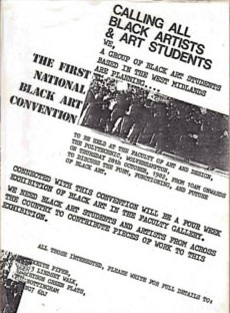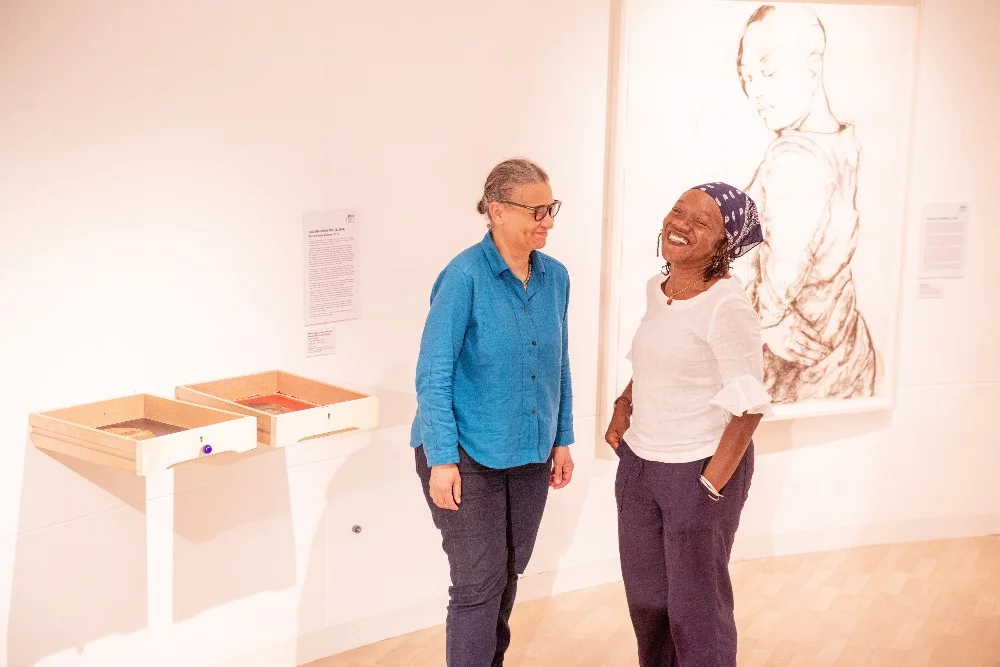In light of International Women’s Day 2019, we are highlighting female artists in our current Speech Acts exhibition. Lubaina Himid, amongst others, made ground-breaking connections when she attended the Black Art Movement convention at Wolverhampton University in 1982. This is particularly important, not only worthy of celebrating on International Women’s day, but should be considered as a vital moment in Britain’s art history.
Image: Poster for the Black Art Convention © www.blkartgroup.info
Information from the BBC4 documentary Whoever Heard of a Black Artist? Black Artists and Modernism highlights stories from the Black Art Convention, which brought together BAME (black and ethnic minority) artists in response to the racial discrimination they were facing in the British art world; where meeting like minded contemporaries changed the artists’ lives.
Claudette Johnson was one of the young artists who met here and initiated a spontaneous break- out session with the other female artists, away from the main hall proceedings. These artists included some recognisable names for us at Manchester Art Gallery, such as Sonia Boyce, whose retrospective was exhibited here back in 2018 and Lubaina Himid, whose work The Tailor is displayed in Gallery 12.
The Tailor (2010) Lubaina Himid, in Gallery 12
“We all showed each other our work and that was the first time I had sat in a room with black women artists, talking about work and feeling the support of that”- Claudette Johnson
Claudette Johnson, 1980’s ©Alchetron
“We shared contact details, which [back then] were addresses and proper telephone numbers, where you stood in the hall and listened to the telephone at the bottom of the stairs. So, it was those days where if you did stay in contact you had to mean it”- Himid
Lubaina Himid, talking about her experience as a Black artist in 1980’s Britain:
“I think we felt that we were doubly invisible, certainly and doubly dead in the first five minutes of a movie or TV programme, so we understood that we could see that we were not visible in newspapers or in magazines. But I guess my personal way of working has been to see what the situation is like and attempt to dig, walk, fight, argue, paint my way out of it.” - Himid
Lubaina Himid and Claudette Johnson ©Muddy Stillettos
Sonia Boyce describes her first meeting with Himid at the Black Art Convention event:
“Lubaina at the end of the conference said ‘give me some slides’ and she gave me her details and I thought that was really sweet, but I had no confidence at that point. Then she wrote to me a few weeks later and said ‘I thought you were going to send me some slides’ and I thought ‘oh she meant it’. And then a few weeks later it was [sent to me] written in really big letters with exclamation marks ‘SEND ME YOUR SLIDES NOW!!’ and I sent her my slides and she was very, very, very strident” - Boyce.
It took over 30 years for the art world to catch up with Lubaina Himid until in 2017, she was the first Black woman to win the Turner Prize, with her work Naming the Money. This work questions the position of Black people in British art history and was displayed as large cut out painted sculptures throughout the historic galleries of Liverpool’s Walker Art Gallery.
Naming the Money (2017) Lubaina Himid in Walker Art Gallery ©National Museums Liverpool
Himid explains in the documentary of her early connections at this conference in 1982, “We have to understand that ‘82 is a long time ago… but it was extraordinary and it was incredibly interesting, but there was very much a male voice.”
Himid began exhibiting Black womens’ work and her big break came in 1985 when she secured her first Black exhibition at the I.C.A mainstream gallery in London called The Thin Black Line which explored the idea that the personal is political. (This exhibition also featured ‘Housewife with Steak Knives’ by Sutapa Biswas, which is also displayed in Speech Acts).
“It felt like we had crossed one of those invisible barriers”- Himid.
The Thin Black Line ICA catalogue ©Making Histories Visible
“It was liberating and affirming to see some of that work and I think the experience of seeing that exhibition really transformed my way of thinking as a Black woman” - Melanie Keen - Li Yuan Chia archive cataloguer at John Ryland’s Library, Manchester).
However, Himid’s work at The Thin Black Line exhibition was heavily criticised, accused of being a ‘cultural terrorist’.
“People definitely thought I was hiding in the bushes with an AK47 and wished to do damage to the art world. But I wanted to make space in the art world and make sure that the gaps that were there were filled. So it hurt, because I don’t want to ambush you, I want to talk to you”- Himid.
Turner Prize winner 2017 Lubaina Himid ©PA Danny Lawson
Through a determined and vociferous career, Himid has achieved the recognition and acceptance from the art world, which untold artists dream of. We can all take great inspiration from Lubaina Himid when celebrating women’s achievements.
#IWD2019
#BalanceforBetter







